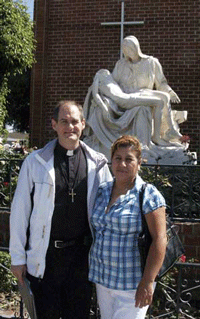Soon after becoming pastor at Mary Immaculate Church in Pacoima, Calif., John Lasseigne, O.M.I., discovered that many of his parishioners were on the verge of losing their homes. The parish in the northeast San Fernando Valley, where home values have dropped by hundreds of thousands of dollars from just a few years ago, is in a working-class, predominantly Latino immigrant area. More than 8,000 homeowners in the region are in default or foreclosure proceedings. “It dawned on all of us that this was going to hit crisis proportions, and fast. We had to act quickly,” said Father Lasseigne.
Contrary to those who argue that those facing foreclosure deserve their fate because they took out risky loans or knowingly bought houses they could not afford, Father Lasseigne says the majority of distressed homeowners he has met these past few months are “very humble, hard-working, honest residents, many of them citizens.…”
“Something we discovered early on, which we’ve tried to convey in every meeting we’ve had with banks and elected officials, is that these mostly Latino homeowners in the San Fernando Valley were targeted by the banking industry,” said Father Lasseigne, who added that many of the borrowers did not understand the risks involved in the subprime loans pushed by aggressive lenders.
In response to the crisis, Father Lasseigne helped form a unique partnership between area parishes and the community-organizing group One-LA, which set out to organize families in default into groups that would negotiate with the banks. Homeowners attended training sessions where they were educated about the basics of mortgages and foreclosures and were put in touch with housing counselors. Approximately 105 homeowners met with banking representatives, including officials from Bank of America, Chase Bank and Wells Fargo. “The banks paid more attention [to homeowners] when we pulled them together,” said Father Lasseigne, but he added that the banks were still offering only “very tiny adjustments” to the mortgages that would provide only short-term help.
California homeowners carrying loans worth more than the current value of their homes, said One-LA housing lawyers, would likely default again when loan modifications, such as temporary principal deferment, ended and interest rates started climbing again. So the coalition presented a plan with a three-pronged approach: get banks to lower the principal on mortgages to reflect the current market value of homes; fix interest rates close to the current market rate; and provide homeowners with small government loans to lower the principal, which would not have to be paid back until the home is sold or the mortgage paid in full. In February the Los Angeles City Council unanimously agreed to provide $1.5 million to fund government loans to 30 homeowners whose lender banks will agree to lower their mortgage loan principal and fix interest rates.
“What we want that pilot project to show is that this plan of reducing principal and fixing interest rates actually produces greater stability in the housing market [resulting in] lower rates of re-default,” said Father Lasseigne. “It’s really [about] showing people that this works. If every party gets involved, it can be done.”








